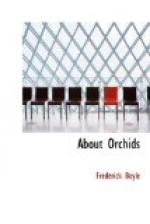The Indian to whom this Cattleya Mossiae belonged refused to part with it at any price for years; he was overcome by a rifle of peculiar fascination, added to the previous offers. A magic-lantern has very great influence in such cases, and the collector provides himself with one or more nowadays as part of his outfit. Under that charm, with 47l. in cash, Mr. Sander secured his first C. Mossiae alba, but it has failed hitherto in another instance, though backed by 100l., in “trade” or dollars, at the Indian’s option.
Thence we pass to a wide and lofty house which was designed for growing Victoria Regia and other tropic water-lilies. It fulfilled its purpose for a time, and I never beheld those plants under circumstances so well fitted to display their beauty. But they generate a small black fly in myriads beyond belief, and so the culture of Nymphaea was dropped. A few remain, in manageable quantities, just enough to adorn the tank with blue and rosy stars; but it is arched over now with baskets as thick as they will hang—Dendrobium, Coelogene, Oncidium, Spathoglottis, and those species which love to dwell in the neighbourhood of steaming water. My vocabulary is used up by this time. The wonders here must go unchronicled.
We have viewed but four houses out of twelve, a most cursory glance at that! The next also is intermediate, filled with Cattleyas, warm Oncidiums, Lycastes, Cypripediums—the inventory of names alone would occupy all my space remaining. At every step I mark some object worth a note, something that recalls, or suggests, or demands a word. But we must get along. The sixth house is cool again—Odontoglossums and such; the seventh is given to Dendrobes. But facing us as we enter stands a Lycaste Skinneri, which illustrates in a manner almost startling the infinite variety of the orchid. I positively dislike this species, obtrusive, pretentious, vague in colour, and stiff in form. But what a royal glorification of it we have here!—what exquisite veining and edging of purple or rose; what a velvet lip of crimson darkening to claret! It is merely a sport of Nature, but she allows herself such glorious freaks in no other realm of her domain. And here is a new Brassia just named by the pontiff of orchidology, Professor Reichenbach. Those who know the tribe of Brassias will understand why I make no effort to describe it. This wonderful thing is yet more “all over the shop” than its kindred. Its dorsal sepal measures three inches in length, its “tail,” five inches, with an enormous lip between. They term it the Squid Flower, or Octopus, in Mexico; and a good name too. But in place of the rather weakly colouring habitual it has a grand decision of character, though the tones are like—pale yellow and greenish; its raised spots, red and deep green, are distinct as points of velvet upon muslin.




